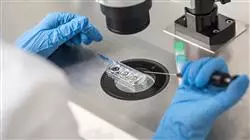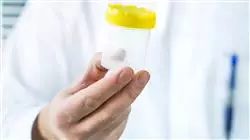University certificate
The world's largest faculty of nursing”
Introduction to the Program
Get up to date on Infertility nursing and become qualified to work in the best Assisted Reproduction units"

This Postgraduate diploma will take the student through several key aspects of Assisted Reproduction: anatomy of human reproduction, neuroendocrinology of reproduction, ovogenesis and spermatogenesis and other fundamental aspects.
Throughout the Postgraduate diploma the student will approach the study of infertility in women from the most basic aspects. Through clinical history, the nursing student will begin by identifying the most important factors involved in it and will learn about the most relevant and frequent pathologies that affect women with infertility and will learn how to perform all the tests and protocols corresponding to their activity.
This program will also explore the field of male infertility, with a broad and specific tour through all aspects of these disorders. This specialization is extremely necessary since nurses are involved in many of the processes related to infertility. The nursing staff may be in charge of performing seminograms, sample analysis and processing, semen freezing, seminal cleaning or even managing the male donor bank.
Another aspect of study of this Postgraduate diploma is the relationship between genetics and immunology and assisted reproduction. The importance of karyotyping in assisted reproduction consultation will also be discussed.
We will review more complex and novel techniques, such as CGH arrays, which are used in preimplantation genetic diagnosis. The key concepts of immunology will also be reviewed, and we will talk about the ever-changing immune system of women and the cell populations that compose it in order to develop the possible problems that can appear when there are autoimmune or alloimmune factors that compromise fertility. The main treatments that can be carried out in these cases will also be discussed. Finally, two specific cases will be discussed, endometriosis and Chlamydia trachomatis infection, which are closely related to inflammation and the immune system.
With this Postgraduate diploma you will be able to combine a high intensity specialization with your professional and personal life, achieving your goals in a simple and real way"
This Postgraduate diploma in Infertility in Assisted Reproductive Nursing contains the most complete and up-to-date scientific program on the market. The most important features include:
- The latest technology in online teaching software
- A highly visual teaching system, supported by graphic and schematic contents that are easy to assimilate and understand
- Practical cases presented by practising experts
- State-of-the-art interactive video systems
- Teaching supported by telepractice
- Continuous updating and recycling systems
- Autonomous learning: full compatibility with other occupations
- Practical exercises for self-evaluation and learning verification
- Support groups and educational synergies: questions to the expert, debate and knowledge forums
- Communication with the teacher and individual reflection work
- Content that is accessible from any fixed or portable device with an Internet connection
- Supplementary documentation databases that are permanently available, even after the program
A very specific specialization that will update you on the latest advances in the field of Infertility in Assisted Reproductive Nursing, with the solvency of a high-quality professional".
Our teaching staff is made up of professionals from different fields related to this specialty. In this way, TECH ensures that it delivers the educational update objective it is aiming for. A multidisciplinary team of professionals specialized and experienced in different environments, who will develop the theoretical knowledge efficiently, but, above all, will put at the service of the program the practical knowledge derived from their own experience: one of the differential qualities of this specialization.
This mastery of the subject matter is complemented by the effectiveness of the methodological design of this program in Assisted Reproduction in Nursing. Developed by a multidisciplinary team of Postgraduate diploma, it integrates the latest advances in educational technology. In this way, you will be able to study with a range of comfortable and versatile multimedia tools that will give you the operability you need in your training.
The design of this program is based on Problem-Based Learning: an approach that conceives learning as a highly practical process. To achieve this remotely, TECH will use telepractice: with the help of an innovative interactive video system, and Learning from an Expert, the student will be able to acquire the knowledge as if he/she were facing the very cases being studied. A concept that will allow students to integrate and memorize what they have learnt in a more realistic and permanent way.
This Postgraduate diploma is supported by the best educational platform and the best online resources to guarantee that your efforts will have the best possible results"

Our innovative telepractice concept will give you the opportunity to learn through an immersive experience: "Learning from an Expert". A system of recognized effectiveness for the integration of knowledge"
Why study at TECH?
TECH is the world’s largest online university. With an impressive catalog of more than 14,000 university programs available in 11 languages, it is positioned as a leader in employability, with a 99% job placement rate. In addition, it relies on an enormous faculty of more than 6,000 professors of the highest international renown.

Study at the world's largest online university and guarantee your professional success. The future starts at TECH”
The world’s best online university according to FORBES
The prestigious Forbes magazine, specialized in business and finance, has highlighted TECH as “the world's best online university” This is what they have recently stated in an article in their digital edition in which they echo the success story of this institution, “thanks to the academic offer it provides, the selection of its teaching staff, and an innovative learning method aimed at educating the professionals of the future”
A revolutionary study method, a cutting-edge faculty and a practical focus: the key to TECH's success.
The most complete study plans on the university scene
TECH offers the most complete study plans on the university scene, with syllabuses that cover fundamental concepts and, at the same time, the main scientific advances in their specific scientific areas. In addition, these programs are continuously being updated to guarantee students the academic vanguard and the most in-demand professional skills. In this way, the university's qualifications provide its graduates with a significant advantage to propel their careers to success.
TECH offers the most comprehensive and intensive study plans on the current university scene.
A world-class teaching staff
TECH's teaching staff is made up of more than 6,000 professors with the highest international recognition. Professors, researchers and top executives of multinational companies, including Isaiah Covington, performance coach of the Boston Celtics; Magda Romanska, principal investigator at Harvard MetaLAB; Ignacio Wistumba, chairman of the department of translational molecular pathology at MD Anderson Cancer Center; and D.W. Pine, creative director of TIME magazine, among others.
Internationally renowned experts, specialized in different branches of Health, Technology, Communication and Business, form part of the TECH faculty.
A unique learning method
TECH is the first university to use Relearning in all its programs. It is the best online learning methodology, accredited with international teaching quality certifications, provided by prestigious educational agencies. In addition, this disruptive educational model is complemented with the “Case Method”, thereby setting up a unique online teaching strategy. Innovative teaching resources are also implemented, including detailed videos, infographics and interactive summaries.
TECH combines Relearning and the Case Method in all its university programs to guarantee excellent theoretical and practical learning, studying whenever and wherever you want.
The world's largest online university
TECH is the world’s largest online university. We are the largest educational institution, with the best and widest online educational catalog, one hundred percent online and covering the vast majority of areas of knowledge. We offer a large selection of our own degrees and accredited online undergraduate and postgraduate degrees. In total, more than 14,000 university degrees, in eleven different languages, make us the largest educational largest in the world.
TECH has the world's most extensive catalog of academic and official programs, available in more than 11 languages.
Google Premier Partner
The American technology giant has awarded TECH the Google Google Premier Partner badge. This award, which is only available to 3% of the world's companies, highlights the efficient, flexible and tailored experience that this university provides to students. The recognition as a Google Premier Partner not only accredits the maximum rigor, performance and investment in TECH's digital infrastructures, but also places this university as one of the world's leading technology companies.
Google has positioned TECH in the top 3% of the world's most important technology companies by awarding it its Google Premier Partner badge.
The official online university of the NBA
TECH is the official online university of the NBA. Thanks to our agreement with the biggest league in basketball, we offer our students exclusive university programs, as well as a wide variety of educational resources focused on the business of the league and other areas of the sports industry. Each program is made up of a uniquely designed syllabus and features exceptional guest hosts: professionals with a distinguished sports background who will offer their expertise on the most relevant topics.
TECH has been selected by the NBA, the world's top basketball league, as its official online university.
The top-rated university by its students
Students have positioned TECH as the world's top-rated university on the main review websites, with a highest rating of 4.9 out of 5, obtained from more than 1,000 reviews. These results consolidate TECH as the benchmark university institution at an international level, reflecting the excellence and positive impact of its educational model.” reflecting the excellence and positive impact of its educational model.”
TECH is the world’s top-rated university by its students.
Leaders in employability
TECH has managed to become the leading university in employability. 99% of its students obtain jobs in the academic field they have studied, within one year of completing any of the university's programs. A similar number achieve immediate career enhancement. All this thanks to a study methodology that bases its effectiveness on the acquisition of practical skills, which are absolutely necessary for professional development.
99% of TECH graduates find a job within a year of completing their studies.
Postgraduate Diploma in Assisted Reproductive Infertility for Nurses
The Postgraduate Diploma in Infertility in Assisted Reproduction for Nursing offered by TECH Global University is an online Postgraduate Diploma designed to train nurses in the field of infertility and assisted reproduction. This Postgraduate Certificate offers an interdisciplinary approach that includes clinical evaluation, pharmacological management, artificial insemination techniques and reproductive surgery. Participants will have the opportunity to explore key topics such as reproductive anatomy and physiology, hormone therapy, ovulation management, gamete and embryo cryopreservation, and advanced technology in assisted reproduction. In addition, you will learn about the ethical, legal and psychological aspects related to infertility and assisted reproduction. If you are looking to grow professionally by acquiring skills in a health area in high demand, you have come to the right place.
Study a postgraduate degree in infertility and assisted reproduction.
This program is designed for those looking to enhance their skills and knowledge in the care of patients with infertility problems, and for those who wish to specialize in this exciting and constantly evolving field. Participants will also have the opportunity to collaborate with other health professionals such as physicians, embryologists and psychologists. One of the main advantages of this postgraduate course is that it is taught entirely online, allowing students to study from anywhere and at any time that is convenient for them. It also has interactive resources, online discussions and a highly trained and accessible teaching staff, as well as cutting-edge academic methodologies that provide optimal results. TECH's Postgraduate Diploma in Assisted Reproductive Infertility for Nursing is a unique opportunity for those looking to enhance their clinical practice and broaden their career prospects in the field of assisted reproduction. enroll now and take the next step in your nursing career!







